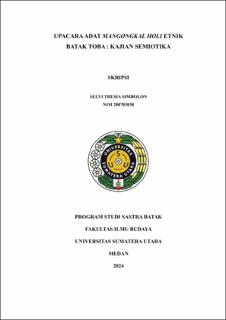Upacara Adat Mangongkal Holi Etnik Batak Toba : Kajian Semiotika
Ethnic Mangongkal Holi Traditional Ceremony Batak Toba: Semiotic Study

Date
2024Author
Simbolon, Selvi Tresia
Advisor(s)
Damanik, Ramlan
Sinulingga, Jekmen
Metadata
Show full item recordAbstract
This thesis is entitled Mangongkal Holi Traditional Ceremony of Toba Batak
Ethnicity: Semiotic Study. This research is qualitative research that uses the
semiotic theory put forward by Charles Sander Peirce. The method used is a
descriptive method located in Parhabinsaran Janji Matogu Village, Uluan District,
Toba Regency. The research results of the traditional Mangongkal Holi ceremony
are divided into 3 stages. The first stage, namely the pre-ceremony of the
Mangongkal Holi traditional ceremony, is divided into two events, namely
manopot batu hula-hula ni si ongkalon (meeting the clans of the wife who will be
exhumed) and martonggo raja (deliberation of Batak traditional leaders). The
second stage is the implementation of Mangongkal Holi, divided into two events,
namely the bone digging event (mangongkal holi), mata ni horja (traditional
party). The third stage, after Mangongkal Holi, is divided into two events,
reburying and manambak (pond party). There are 25 symbols: Pinahan Lobu,
Dekke Sitio-tio, Pond: monument, Gorga Simata Ni Ari, Gorga Ipon-Ipon, Gorga
Gaja Dompak, Gorga Sompi-sompi, Ulos Ragidup, Gorga Jogia, Gorga Batu
Assimun, Gorga Sigumang, Gorga Pinarhalak Boru, Gorga Pinarhalak Bawa,
Gorga Lipan-Lipan, Ulos Sadum Panoropi, Money, Kaffir lime juice and turmeric,
Ruma-ruma: Small chest, Demban Tiar, Sortali Boru, Sortali Bawa, Buffalo,
Somba Marhula-Hula, Elek Marboru , Manat Mardongan Tubu
Collections
- Undergraduate Theses [245]
